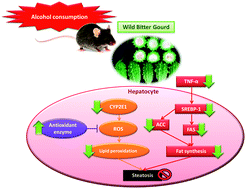Wild bitter gourd protects against alcoholic fatty liver in mice by attenuating oxidative stress and inflammatory responses
Abstract
Bitter gourd (Momordica charantia L.) is a common vegetable grown widely in Asia that is used as a traditional medicine. The objective of this study was to investigate whether wild bitter gourd possessed protective effects against chronic alcohol-induced liver injury in mice. C57BL/6 mice were fed an alcohol-containing liquid diet for 4 weeks to induce alcoholic fatty liver. Meanwhile, mice were treated with ethanol extracts from four different wild bitter gourd cultivars: Hualien No. 1′, Hualien No. 2′, Hualien No. 3′ and Hualien No. 4′. The results indicated that the daily administration of 500 mg kg body weight−1 of a Hualien No. 3′ extract (H3E) or a Hualien No. 4′ extract (H4E) markedly reduced the steatotic alternation of liver histopathology. In addition, the activation of serum aminotransferases (AST and ALT) and the accumulation of hepatic TG content caused by alcohol were ameliorated. The hepatoprotective effects of H3E and H4E involved the enhancement of the antioxidant defence system (GSH, GPx, GRd, CAT and SOD), inhibition of lipid peroxidation (MDA) and reduction of pro-inflammatory cytokines (TNF-α, IL-1β and IL-6) in the liver. Moreover, H3E and H4E supplementation suppressed the alcohol-induced elevation of CYP2E1, SREBP-1, FAS and ACC protein expression. These results demonstrated that ethanol extracts of Hualien No. 3′ and Hualien No. 4′ have beneficial effects against alcoholic fatty liver, in which they attenuate oxidative stress and inflammatory responses.


 Please wait while we load your content...
Please wait while we load your content...